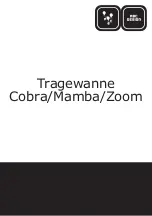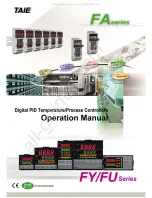
CHAPTER 5: SETTINGS
CONTROL ELEMENTS
L90 LINE CURRENT DIFFERENTIAL SYSTEM – INSTRUCTION MANUAL
5-337
5
initiate three-pole reclosing in situations where single-pole tripping commands are changed to three-pole tripping
commands. This can happen in cases where the phase selector identifies a multi-phase fault or the
AR FORCE 3P TRIP
command is present.
TRIP SEAL-IN DELAY
— This setting specifies the minimum time that trip command signals are maintained to provide
sufficient time to open the breaker poles. If a value of “0” is specified, then the output signal is reset once the protection
elements initiating the trip are reset. If a value other than “0” is specified, then the protection elements must reset and the
timer initiated at the first trip command must expire.
TRIP RESET
— This setting selects the option to reset the trip latches. If “Pole Curr OR Custom” is chosen, then program the
OPEN POLE CURRENT PKP
setting accordingly. If “CBaux OR Custom” is chosen, then set the breakers appropriately. Both the
“Current” and “CBaux” options can be complimented by custom conditions using the
BKR
Φ
A OPEN
,
BKR
Φ
B OPEN
, and
BKR
Φ
C OPEN
settings indicated below. Alternately, a purely custom condition can be applied to reset trip output latches.
START TMR Z2PH Inp1
and
START TMR Z2PH Inp2
— These settings select an operand that starts the phase distance zone 2
timer to avoid a trip delay if the fault evolves from one type to another type (for example, from a single-line–to-ground fault
to a multi-phase fault) or from one zone of protection to another zone of protection (for example, from zone 3 to zone 2).
For instance, the
GND DIST Z2 PKP
FlexLogic operand or the
PH DIST Z3 PKP
FlexLogic operand can be assigned to either of
these settings. Use a FlexLogic OR-gate if more than two inputs are required. See the phase distance logic diagrams for
information.
START TMR Z2GR Inp1
and
START TMR Z2GR Inp2
— These settings select an operand that starts the ground distance zone 2
timer to avoid a trip delay if the fault evolves from one zone of protection to another zone of protection (for example, from
zone 3 to zone 2). For instance, the
GND DIST Z3 PKP
FlexLogic operand can be assigned to these settings. Use a FlexLogic
OR-gate if more than two inputs are required. See the ground distance logic diagrams for information.
PH SELECTOR RST DELAY
— This setting specifies the reset delay of the Phase Selector element outputs after system
disturbance occurs. This delay has to be long enough to allow elements assigned to cause single-pole tripping to operate.
If, for example, it is intended that distance zone 2 with a time delay of 0.5 seconds causes a single-pole trip, then this
setting has to be at least 0.6 seconds.
PH SELECTOR RESET
— This setting selects an operand to reset the Phase Selector element. The selected operand is ORed
with the
OPEN POLE OP
operand internally to reset the phase selector element. See the Phase Selection section in the Theory
of Operation chapter for details.
TRIP FORCE 3-POLE
— Selects an operand that forces an input selected for single pole operation to produce a three-pole
operation. The
AR DISABLED
FlexLogic operand is the recommended value for this setting. Power system configurations or
conditions that require such operations can be considered as well.
TRIP PILOT PRIORITY
— This setting is used to set an interval equal to the inter-relay channel communications time, plus a
margin, during which outputs are not asserted. This delay permits fault identification information from a remote terminal
to be used instead of local data only.
REVERSE FAULT
— Use this setting to guarantee accuracy of single-pole tripping under evolving external to internal faults.
When a close-in external fault occurs, the relay is biased toward very fast operation on a following internal fault. This is
primarily due to depressed voltages and elevated currents in response to the first, external fault. The phase selector can
exhibit some time lag compared to the main protection elements. This can potentially result in a spurious three-pole
operation on a single-line-to-ground internal fault. Delaying tripping on internal faults that follow detection of reverse
faults solves the problem.
As long as the operand indicated under this setting is asserted the trip action is delayed by
TRIP DELAY ON EVOLV FAULTS
time. Typically this operand should combine reverse zone indications (such as zone 4 pickup) with a half-cycle pickup delay,
and two-cycle dropout delay. Use this setting only in single-pole tripping applications, when evolving faults are of
importance, and slightly delayed operation on evolving faults can be traded for enhanced accuracy of single-pole tripping.
TRIP DELAY ON EVOLV FAULTS
— Use this setting in conjunction with the preceding
REVERSE FAULT
setting. Typically this value
is set around half a power system cycle. Use it only in single-pole tripping applications, when evolving faults are of
importance, and slightly delayed operation on evolving faults can be traded for enhanced accuracy of single-pole tripping.
BKR
Φ
A OPEN
,
BKR
Φ
B OPEN
, and
BKR
Φ
C OPEN
— These settings are used to select an operand to indicates that phase A, B, or
C of the breaker is open, respectively.
















































